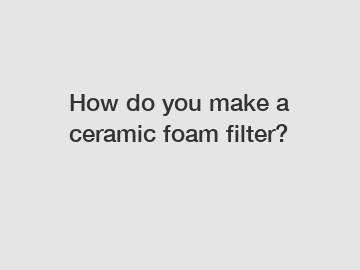Dec. 29, 2023
Minerals
How do you make a ceramic foam filter?
Ceramic foam filters are widely used in various industries for their ability to effectively remove impurities from molten metals. These filters are porous structures made of ceramic material, which allows for the passage of liquid metal while trapping any solid impurities. In this article, we will explore the process of making a ceramic foam filter, step by step.
Materials needed:

- Ceramic powder (usually silicon carbide or alumina).
- Foam material (polyurethane foam).
- Binder solution (a mixture of water and organic binder).
- Hardener (ammonium hydroxide).
- Drying equipment (oven or kiln).
- Firing equipment (furnace).
- Mold or frame for shaping the filter.
Step 1: Preparation of Ceramic Slurry.
The first step in making a ceramic foam filter is preparing the ceramic slurry. A ceramic slurry is a mixture of ceramic powder, binder solution, and hardener. The ratio of these materials may vary depending on the desired properties of the filter. The ceramic powder is typically mixed with water and organic binder to form a paste-like consistency. Then, a small amount of hardener is added to initiate the solidification process.
Step 2: Impregnation of Foam.
In this step, the foam material is impregnated with the ceramic slurry. The foam acts as a template for the filter's pore structure. The foam is typically cut into the desired shape and size to fit into a mold or frame. The foam is then soaked or dipped into the ceramic slurry mixture, ensuring that all the pores of the foam are filled with the slurry.
Step 3: Removal of Excess Slurry.
After impregnating the foam with the ceramic slurry, excess slurry is removed. This can be done by gently squeezing or shaking the foam to allow the excess slurry to drain off. The goal is to have the ceramic slurry only remain in the pores of the foam material, creating the desired ceramic structure.
Step 4: Drying.
The next step involves drying the impregnated foam. The foam can be air-dried, but a more controlled drying process can be achieved by using an oven or kiln. The drying temperature and duration depend on the specific materials used. The drying process removes the water content from the ceramic slurry, leaving behind a solid ceramic structure within the foam.
Step 5: Firing.
Once the foam is completely dried, it is ready for firing. Firing is the process of subjecting the foam to high temperatures to sinter the ceramic powder. This step further strengthens the ceramic structure and removes any organic binders or residues. The firing temperature and duration depend on the type of ceramic material used. After firing, the foam structure is replaced with a highly porous ceramic foam filter.
Closing Paragraph:
In summary, making a ceramic foam filter involves preparing a ceramic slurry, impregnating foam with the slurry, removing excess slurry, drying the foam, and finally, firing it at high temperatures. These filters play a critical role in industries such as foundries and metal casting, where the removal of impurities from molten metals is essential for producing high-quality products. If you have any further questions or would like to inquire about ceramic foam filters, please do not hesitate to contact us.
Keywords: contact us.
For more Fiberglass Filter Pouches, Fiberglass Filtration Products, Fiberglass Filtration Filter Pouchinformation, please contact us. We will provide professional answers.
Previous: Which Metal Wire Mesh Warranty Offers Unparalleled Durability?
Next: Revolutionize Filtration: All About Titanium Filter Mesh – Efficiency, Durability & Maintenance
If you are interested in sending in a Guest Blogger Submission,welcome to write for us!
All Comments ( 0 )